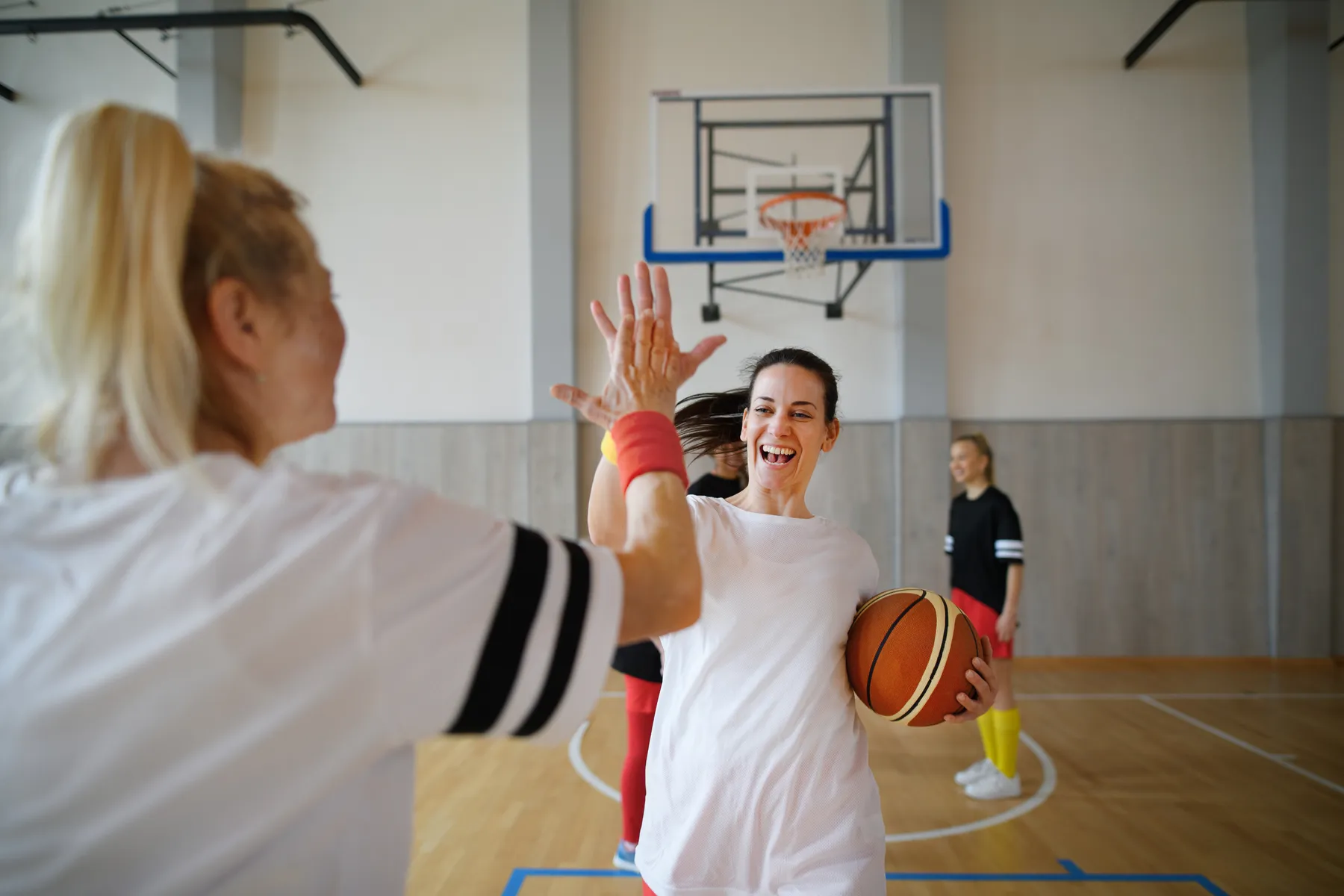Introduction
Athletes, coaches, and fans have argued these topics for decades. Why do two completely different sports dispute so much? Some like playing with others, while others want control. This blog post compares team and individual sports to explain their pros and cons. Want to play one of these sports? Find out their advantages and downsides!
Advantages of playing team sports
Enhanced Communication Skills:
Players in a team need to be able to communicate clearly and efficiently with one another. Because of the consistent connection, verbal and nonverbal communication skills are being developed and improved.
Fosters Teamwork and Cooperation:
Participating in team sports is a fantastic opportunity to acquire the skills necessary to work cooperatively toward a common objective, with an awareness of each team member’s roles and how they contribute to the overall success.
Develops Leadership Skills:
Players frequently receive the opportunity to lead in team sports, which is beneficial for developing their leadership qualities.
Physical Health:
Participating in team sports regularly can benefit one’s physical health because these sports frequently involve strenuous training and activities.
Higher Self-esteem:
Being a team member can benefit a player’s self-esteem and confidence because it makes them feel respected and valuable to the group.
Social Connections:
Team sports allow participants to develop new social connections and friendships, resulting in a more fulfilling social life.
Different types of team sports exist.
Football (Soccer):
Football, also referred to as “the beautiful game,” is the most played team sport in the entire globe. It calls for outstanding cooperation among team members, skill, and strategic thinking.
Basketball:
The game moves at a breakneck pace and requires individual skill and team strategy, emphasizing shooting, passing, and dribbling skills.
Baseball:
Baseball is a traditional sport in the United States that mixes elements of individual performance (such as pitching and hitting) with elements of team strategy (such as fielding positions and base running).
Cricket:
Cricket, a sport played in many countries that are members of the Commonwealth, consists of batting, bowling, and fielding, and it requires a high level of strategic team play.
Rugby:
Players need to collaborate, use their power, and think strategically to advance the ball across the field in rugby, which is well-known for its roughness.
Volleyball:
It is a sport that requires exceptional cooperation among teammates, clear and effective communication, and quick reactions to maintain the ball in play.
Hockey:
The characteristics of speed, skill, and teamwork are essential to success in both field and ice hockey. Players must coordinate their efforts to advance the puck or ball closer to the net.
Netball:
Netball is a team sport that is played primarily by women and places an emphasis on passing and shooting. Players are given certain duties within the team.
Pros and cons of individual sports
Pros
Personal Responsibility:
In sports where players compete against one another, the game’s result is determined by how well the players do. In competitive sports, where players go up against one another, the game’s outcome depends on how well the participants perform.
Self-Pacing:
In sports where players compete against one another, the game’s result is determined by how well the players do. Athletes can advance at their speed without being required to match up to a team’s average skill level, allowing them to test their potential limits at leisure.
Flexible Schedule:
In sports where players compete against one another, the game’s result is determined by how well the players do. Because individual athletes do not need to coordinate their training schedules with a team, there is more leeway for scheduling flexibility.
Personal Glory:
In sports where players compete against one another, the game’s result is determined by how well the players do because there is no team to share the glory with; an individual athlete who achieves success in an individual sport receives all the recognition.
Mental Strength:
In sports where players compete against one another, the game’s result is determined by how well the players do. Mental toughness can be developed by participation in individual sports because players frequently have to motivate themselves and confront problems alone.
Cons
Pressure:
In sports where players compete against one another, the game’s result is determined by how well the players do. Because there is no team to blame or share defeat with, the pressure that comes with individual sports may be great.
Lack of Teamwork:
In sports where players compete against one another, the game’s result is determined by how well the players do. Individual sports allow participants to build collaboration and cooperative skills compared to team sports.
Injury Risks:
In sports where players compete against one another, the game’s result is determined by how well the players do. The outcome of a game in a sport in which players compete against one another is determined by how well the players perform relative to one another.
Social Isolation:
In sports where players compete against one another, the game’s result is determined by how well the players do. Participating in solitary sports may foster greater self-reliance in athletes. However, without the sense of community that accompanies team sports participation, they might also encounter emotions of alienation.
Cost:
In sports where players compete against one another, the game’s result is determined by how well the players do. Solo athletes typically have higher costs than team players because they cannot share costs like equipment or coaching with their teammates.
The importance of having a coach or mentor to help you with your sport
In sports where players compete against one another, the game’s result is determined by how well the players do. The presence of coaches or mentors greatly impacts the path of an individual athlete. The following are some of the benefits they provide:
Training and Strategy:
In sports where players compete against one another, the game’s result is determined by how well the players do. Most of the time, coaches are seasoned specialists who can impart knowledge to their athletes regarding effective training methods, game strategies, and approaches particular to their sport. They collaborate with athletes to develop their talents, improve their fitness levels, and devise game strategies.
Motivation and Encouragement:
In sports where players compete against one another, the game’s result is determined by how well the players do. An athlete might receive much-needed inspiration and encouragement from their coach if the coach acknowledges the athlete’s hard work and achievements. They can motivate athletes to push through challenges and achieve new levels of success.
Personal Growth:
In sports where players compete against one another, the game’s result is determined by how well the players do. Not only do coaches concentrate on an athlete’s performance, but they also concentrate on their personal development. They instill discipline, tenacity, and resilience, all vital attributes within and outside the sporting arena.
Mental Health Support:
In sports where players compete against one another, the game’s result is determined by how well the players do. Sports can be hard on the emotions. A good teacher knows this and helps athletes deal with stress, anxiety, and the pressures of competition by being there for them emotionally.
Career Guidance:
In sports where players compete against one another, the game’s result is determined by how well the players do. A coach can help athletes who want to compete professionally move up in their careers by helping them choose the right events, find a balance between training and other obligations, and deal with the media.
The different levels of competition in individual and team sports
In sports where players compete against one another, the game’s result is determined by how well the players do. In the world of sports, there are varying degrees of competition, ranging from recreational to professional, with various phases in between. These levels reflect the expertise, experience, and commitment an athlete or team has to their chosen sport.
Amateur Level:
In sports where players compete against one another, the game’s result is determined by how well the players do. The beginning of a person’s journey in a given sport typically begins at this level. It generally encompasses school activities, leisure leagues, and local sports groups. Learning the principles of the sport, improving one’s skills, and having fun while playing are the primary goals of this section.
Collegiate Level:
At the collegiate level, athletes who exhibit exceptional proficiency are allowed to compete and will be required to represent their respective universities or institutions. The level of competition is far higher here, and players frequently have to juggle their athletic commitments with their academic responsibilities.
Semi-Professional Level:
Athletes competing at the semi-pro level may do so in regional or national leagues. They may earn some compensation for their participation, but in most cases, they still need to pursue a separate line of work to make ends meet financially.
Professional Level:
National and international professional athletes make a livelihood. This is the top athletic competition. They often get world-class coaching, training, and medical care.
Each level has unique challenges and rewards. Moving up levels requires dedication, skill, and determination. However, athletes may grow emotionally and professionally while enjoying the pure pleasure and fulfillment of athletics.
Mental health benefits that come from participating in both individual and team sports
It is a well-known fact that engaging in sporting activities, whether individually or as a team member, has a substantial positive impact on mental health.
Stress Relief:
Your body’s stress chemicals, like adrenaline and cortisol, decrease when you work out regularly. It also makes your body make more endorphins and natural mood boosters to help you avoid worry and depression.
Boosts Confidence:
Self-esteem and confidence can increase when you reach your goals or improve at an activity. This could mean beating a personal best, winning a game, or doing better than before.
Teaches Resilience:
The ability to overcome obstacles and brush off setbacks is essential in sports, which frequently provide testing situations. Athletes train themselves to be resilient and persistent, which is good for their mental health and benefits them in their athletic careers.
Promotes Social Interaction:
Participating in team sports offers the opportunity to communicate with and become closer to other people. This type of social engagement can help ease feelings of loneliness and isolation while fostering a sense of belonging in its participants.
Improves Sleep Habits:
Maintaining a regular exercise routine has been shown to improve sleep patterns. Quality sleep is necessary for maintaining good mental health because it allows the brain to rest and replenish itself.
Assists in Controlling Addictive Behaviors:
Individuals who struggle to control their addictive habits may find that participating in sports, with its associated routines and disciplines, offers a more constructive outlet for their time and energy.
Encourages Better Eating Habits:
Participation in sports regularly might help foster healthy eating habits, which are associated with better mental health outcomes.
Conclusion
Finally, team and individual sports are healthy. They change you mentally, physically, and socially. Coaches and mentors inspire, develop, and assist amateur athletes to become pros. Despite their difficulty, these levels provide life lessons. Sports are important because they relieve stress, increase strength, make friends, and enhance sleep and diet. No matter your preference, solitary or team sports have various benefits.





